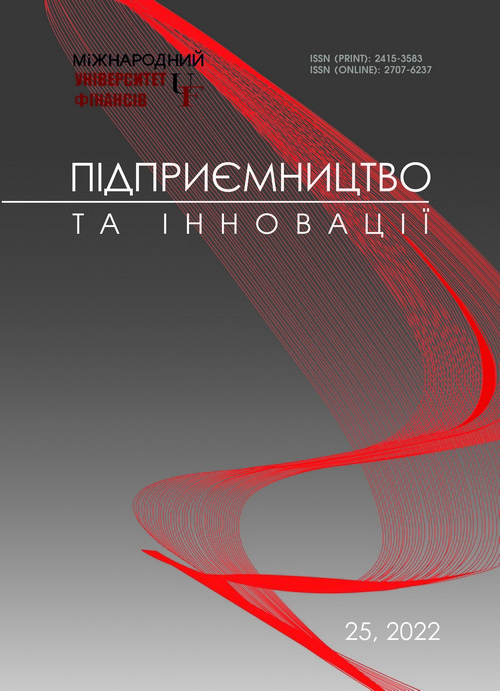КОНЦЕПТУАЛЬНА МОДЕЛЬ ЗЕЛЕНОЇ ЕКОНОМІКИ У ФРЕЙМІ ГЛОБАЛЬНИХ СУСПІЛЬНИХ БЛАГ ТА СТАЛОГО РОЗВИТКУ
Анотація
Автором ідентифіковані шість ключових моделей глобального розвитку за сценаріями конвергенції його економічного та екологічного компонентів. Проаналізовані пари антагоністичних моделей еко-економічного розвитку, що утворюються в координатах «рівень розвитку – екологічність інновацій». В статті стверджується, що трансдисциплінарний характер наукового дискурсу сталого розвитку та зеленої економіки дав змогу не тільки підтвердити цілу низку гіпотез у суміжних галузях знань, але й згенерувати появу значної кількості новітніх теорій і концепцій. Одним з вдалих прикладів цього автор вважає концепцію глобальних публічних благ. В контексті даної концепції запропоновані інституційні особливості розвитку зеленої економіки та управління процесами мінімізації негативного впливу економічного розвитку на довкілля. Автор стверджує, що у контексті екологічної стійкості зелена економіка діє як всезагальна теорія, що включає окремі структурні компоненти концепцій циркулярної та біоекономіки. В статті запропоновано концептуально нове бачення зеленої економіки, яке відрізняється від існуючих авторським обґрунтуванням якісно нової субординаційної ієрархії ключових компонентів зеленої економіки як базису забезпечення сталого розвитку за дотримання при цьому принципу компліментарності авторських підходів і попередніх наукових здобутків інших авторів.
Посилання
Ekins P., Domenech T., Drummond P., Bleischwitz R., Hughes N., Lotti L. The Circular Economy: What, Why, How and Where. OECD/EC Workshop «Managing environmental and energy transitions for regions and cities», Paris. 5-th July 2019. URL: https://www.oecd.org/cfe/regionaldevelopment/Ekins-2019-Circular-Economy-What-Why-How-Where.pdf
D’Amato D., Droste N., Allen B., Kettunen M., Lähtinen K., Korhonen J., Leskinen P., Matthies B. D., Toppinen A. Green, circular, bio economy: A comparative analysis of sustainability avenues. Journal of Cleaner Production. 2017. Vol. 168. P. 716–734.
Franceschini S., Pansera M. Beyond unsustainable eco-innovation: the role of narratives in the evolution of the lighting sector. Technological Forecasting & Social Change. 2015. № 92. P. 69–83.
Gowdy J., Mesner S. The Evolution of Georgescu-Roegen’s Bioeconomics. Review of Social Economy. 1998. Vol. 56. No. 2. P. 136–156.
Innovating for sustainable growth: A bioeconomy for Europe. Report. EU and Governance. URL: https://www.ecsite.eu/activities-and-services/resources/innovating-sustainable-growth-bioeconomy-europe
The Forest Sector in the Green Economy. Geneva Timber and Forest Discussion Papers. UN Economic Commission for Europe December 2011.
Towards a Green Economy: Pathways to Sustainable Development and Poverty Eradication. UNEP. Nairobi. URL: https://sustainabledevelopment.un.org/content/documents/126GER_synthesis_en.pdf
Geissdoerfer M., Savaget P., Bocken N., Hultink E. J. The Circular Economy – A new sustainability paradigm?’. Journal of Cleaner Production. 2017. Vol. 143. DOI: https://doi.org/10.1016/j.jclepro.2016.12.048
Chin M. What are global public goods? Finance & Development. IMF. December 2021. URL: https://www.imf.org/en/Publications/fandd/issues/2021/12/Global-Public-Goods-Chin-basics
Impacts of circular economy policies on the labour market. Cambridge Econometrics, Trinomics, and ICF. 2018. URL: https://circulareconomy.europa.eu/platform/sites/default/files/ec_2018_-_impacts_of_circular_economy_policies_on_the_labour_market.pdf
Kirchherr J., Reike D., Hekkert M. Conceptualizing the circular economy: An analysis of 114 definitions’. Resources, Conservation and Recycling. 2017. Vol. 127. P. 221–232.
Economics of the environment. in Essentials of Economics in Context. By Neva Goodwin, Jonathan M. Harris, Pratistha Joshi Rajkarnikar, Brian Roach, Tim B. Thornton. 1st Edition. Routledge. 2020.
Keith D. A., Ferrer-Paris J. R., Nicholson E., Kingsford R. T., eds. The IUCN Global Ecosystem Typology 2.0: Descriptive profiles for biomes and ecosystem functional groups. Gland, Switzerland: IUCN, 2020.
Цифрова економіка: вплив інформаційно-комунікаційних технологій на людський капітал та формування компетентностей майбутнього: монографія / М-во освіти і науки України, ДВНЗ «Київ. нац. екон. ун-т ім. В. Гетьмана»; за ред. Антонюк Л., Ільницького Д., Севастюк А. Київ : КНЕУ, 2021. URL: https://ir.kneu.edu.ua:443/handle/2010/36436
Hidalgo C. A., Hausmann R. The building blocks of economic complexity. Proceedings of National Academy of Science. 2009. Vol. 106 (26). P. 10570–10575.
Mealy P., Teytelboym A. Economic complexity and the green economy. Research Policy. 2020. URL: https://www.sciencedirect.com/science/article/pii/S0048733320300287?via%3Dihub
Miedzinski M. Accelerating the Evolution of Climate Innovation Clusters. CLIMATE INNOVATION INSIGHTS. Series 1.3. URL: https://www.climate-kic.org/wp-content/uploads/2017/03/Insight03_Proof4.pdf
Ekins P., Domenech T., Drummond P., Bleischwitz R., Hughes N., Lotti L. (2019) The Circular Economy: What, Why, How and Where. OECD/EC Workshop «Managing environmental and energy transitions for regions and cities», Paris. 5-th July. Available at: https://www.oecd.org/cfe/regionaldevelopment/Ekins-2019-Circular-Economy-What-Why-How-Where.pdf
D’Amato D., Droste N., Allen B., Kettunen M., Lähtinen K., Korhonen J., Leskinen P., Matthies B. D., Toppinen A. (2017) Green, circular, bio economy: A comparative analysis of sustainability avenues. Journal of Cleaner Production.Vol. 168. P. 716–734.
Franceschini S., Pansera M. (2015) Beyond unsustainable eco-innovation: the role of narratives in the evolution of the lighting sector. Technological Forecasting & Social Change. №92. P. 69–83.
Gowdy J., Mesner S. (1998) The Evolution of Georgescu-Roegen’s Bioeconomics. Review of Social Economy. Vol. 56. No. 2. P. 136–156.
Innovating for sustainable growth: A bioeconomy for Europe. Report. EU and Governance. Available at: https://www.ecsite.eu/activities-and-services/resources/innovating-sustainable-growth-bioeconomy-europe
The Forest Sector in the Green Economy. (2011) Geneva Timber and Forest Discussion Papers. UN Economic Commission for Europe December.
Towards a Green Economy: Pathways to Sustainable Development and Poverty Eradication. UNEP. Nairobi. Available at: https://sustainabledevelopment.un.org/content/documents/126GER_synthesis_en.pdf
Geissdoerfer M., Savaget P., Bocken N., Hultink E. J. (2017) The Circular Economy – A new sustainability paradigm?’ Journal of Cleaner Production. Vol. 143. DOI: https://doi.org/10.1016/j.jclepro.2016.12.048
Chin M. (2021) What are global public goods? Finance & Development. IMF. December Available at: https://www.imf.org/en/Publications/fandd/issues/2021/12/Global-Public-Goods-Chin-basics
Impacts of circular economy policies on the labour market. (2018) Cambridge Econometrics, Trinomics, and ICF. Available at: https://circulareconomy.europa.eu/platform/sites/default/files/ec_2018_-_impacts_of_circular_economy_policies_on_the_labour_market.pdf
Kirchherr J., Reike D., Hekkert M. (2017) Conceptualizing the circular economy: An analysis of 114 definitions’. Resources, Conservation and Recycling. Vol. 127. P. 221–232.
Economics of the environment. in Essentials of Economics in Context. (2020) By Neva Goodwin, Jonathan M. Harris, Pratistha Joshi Rajkarnikar, Brian Roach, Tim B. Thornton. 1st Edition. Routledge.
Keith D. A., Ferrer-Paris J. R., Nicholson E., Kingsford R. T., eds. (2020) The IUCN Global Ecosystem Typology 2.0: Descriptive profiles for biomes and ecosystem functional groups. Gland, Switzerland: IUCN.
Tsifrova ekonomika: vpliv informatsiyno-komunikatsiynih tehnologiy na ludskiy kapital ta formuvannia kompetentnostey maybutnyogo: monografia (in Ukrainian) [Digital economy: the impact of information and communication technologies on human capital and the formation of future competencies]: a monograph / edited by Antonyuk L., Ilnytskiy D., Sevastyuk A. (2021) Kyiv: KNEU.
Hidalgo C. A., Hausmann R. (2020) The building blocks of economic complexity. Proceedings of National Academy of Science. 2009. Vol. 106 (26). P. 10570–10575.
Mealy P., Teytelboym A. Economic complexity and the green economy. Research Policy. Available at: https://www.sciencedirect.com/science/article/pii/S0048733320300287?via%3Dihub
Miedzinski M. (2017) Accelerating the Evolution of Climate Innovation Clusters. CLIMATE INNOVATION INSIGHTS. Series 1.3. Available at: https://www.climate-kic.org/wp-content/uploads/2017/03/Insight03_Proof4.pdf



